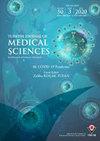利用超声波预测病态肥胖患者的困难气道
IF 1.2
4区 医学
Q2 MEDICINE, GENERAL & INTERNAL
引用次数: 0
摘要
.气道插管困难有几个临床决定因素,包括 背景/目的:面罩通气困难和插管困难在肥胖患者中更为常见。超声是评估气道的一种可靠且无创的方法。本研究旨在探讨超声波测量的不同水平的颈前软组织(ANS)厚度、舌体积(TV)、舌齿间距(HMD)、会厌前距离与会厌和声带中点之间的距离之比(PE/E-VC)在预测病态肥胖患者气道困难中的贡献和可用性。材料与方法:2020 年 3 月至 2020 年 11 月期间,费拉特大学医院将年龄≥18 岁、体重指数(BMI)≥40 kg/m2 且在全身麻醉下接受择期手术的患者纳入这项前瞻性研究。在对患者进行术前评估时,使用超声波测量并记录TV、不同水平的ANS厚度、HMD和PE/E-VC的比率。使用 Cormack-Lehane 分类系统识别插管困难的患者。记录球囊面罩通气困难的患者。随后,比较了插管容易和插管困难患者的参数。此外,还比较了容易和困难喉罩通气患者的参数。结果插管困难的肥胖患者在甲状舌骨膜水平的声门前ANS厚度和PE/E-VC值明显大于插管容易的肥胖患者(P < 0.001)。此外,在喉罩通气困难的肥胖患者中,TV(p < 0.001)、甲状舌骨膜水平的声门前ANS厚度(p < 0.001)、甲状腺峡部水平的ANS厚度(p = 0.002)、ANS-胸骨上切迹厚度(p = 0.004)和PE/E-VC(p = 0.005)值均明显增加。结论超声可能是预测困难气道和困难喉罩通气的有用工具。为此,可使用超声波测量不同水平的 ANS 厚度、PE/E-VC 和 TV 值。本文章由计算机程序翻译,如有差异,请以英文原文为准。
Predicting difficult airway in morbidly obese patients using ultrasound
. There are several clinical determinants for difficult airway intubation, including Background/aim: Difficult mask ventilation and difficult intubation are more common in obese patients. Ultrasound is a reliable and noninvasive method for evaluating the airway. The aim of this study was to investigate the contribution and availability of anterior neck soft tissue (ANS) thickness at different levels, tongue volume (TV), hyomental distance (HMD), the ratio of preepiglottic distance to distance between the epiglottis and the midpoint of vocal cords (PE/E-VC) measured by ultrasonography in predicting difficult airway in morbidly obese patients. Materials and methods: Between March 2020 and November 2020, patients aged ≥18 years with a body mass index (BMI) of ≥40 kg/m2 who underwent elective surgery under general anesthesia were included in this prospective study at Fırat University Hospital. During the preoperative evaluation of patients, ultrasound was used to measure and record TV, ANS thickness at different levels, HMD, and ratio of PE/E-VC. Patients with difficult intubation were identified using the Cormack-Lehane classification system. Patients whohad difficulties with balloon mask ventilation were recorded. Subsequently, the parameters of patients with easy and difficult intubation were compared. In addition, the parameters of patients with easy and difficult mask ventilation were also compared. Results: The preepiglottic ANS thickness at the level of the thyrohyoid membrane and the PE/E-VC value in obese patients with difficult intubation were significantly greater than in obese patients with easy intubation (p < 0.001). In addition, TV (p < 0.001), preepiglottic ANS thickness at the thyrohyoid membrane level (p < 0.001), ANS thickness at the thyroid isthmus level (p = 0.002), ANS-suprasternal notch thickness (p = 0.004), and PE/E-VC (p = 0.005) values were significantly greater in obese patients with difficult mask ventilation. Conclusion: Ultrasound may be a useful tool for predicting difficult airway and difficult mask ventilation. For this purpose, ANS thickness at different levels, PE/E-VC, and TV values measured by ultrasound can be used.
求助全文
通过发布文献求助,成功后即可免费获取论文全文。
去求助
来源期刊

Turkish Journal of Medical Sciences
医学-医学:内科
CiteScore
4.60
自引率
4.30%
发文量
143
审稿时长
3-8 weeks
期刊介绍:
Turkish Journal of Medical sciences is a peer-reviewed comprehensive resource that provides critical up-to-date information on the broad spectrum of general medical sciences. The Journal intended to publish original medical scientific papers regarding the priority based on the prominence, significance, and timeliness of the findings. However since the audience of the Journal is not limited to any subspeciality in a wide variety of medical disciplines, the papers focusing on the technical details of a given medical subspeciality may not be evaluated for publication.
 求助内容:
求助内容: 应助结果提醒方式:
应助结果提醒方式:


